Non-Destructive Evaluation of the Quality of Adhesive Joints Using Ultrasound, X-ray, and Feature-Based Data Fusion
Abstract
1. Introduction
2. Materials and Methods
- Data acquisition (using ultrasonic and radiography techniques);
- Modelling of ultrasonic signal to determine the zone of interest in ultrasonic A-scans;
- Feature extraction;
- Feature-based data fusion;
- Evaluation of results.
2.1. Sample Description
2.2. Investigation Techniques
2.2.1. Immersion Ultrasonic Testing
2.2.2. Radiographic Testing
2.3. Ultrasonic Signal Modelling
2.4. Data Fusion
2.4.1. Preparation of Data for Data Fusion
2.4.2. Selection of Features
2.4.3. Data Fusion Algorithms
3. Results
3.1. Features
3.2. Data Fusion
4. Comparison of Different Techniques and Discussion
5. Conclusions
Author Contributions
Funding
Institutional Review Board Statement
Informed Consent Statement
Data Availability Statement
Conflicts of Interest
References
- Tserpes, K.; Sioutis, I.; Floros, G.; Moutsompegka, E. Numerical simulation of debonding of a composite-to-metal adhesive joint subjected to centrifugal load. Eng. Fail. Anal. 2022, 136, 106131. [Google Scholar] [CrossRef]
- Yilmaz, B.; Smagulova, D.; Jasiuniene, E. NDT and E International Model-assisted reliability assessment for adhesive bonding quality evaluation with ultrasonic NDT. NDT E Int. 2022, 126, 102596. [Google Scholar] [CrossRef]
- Smagulova, D.; Mazeika, L.; Jasiuniene, E. Novel Processing Algorithm to Improve Detectability of Disbonds in Adhesive Dissimilar Material Joints. Sensors 2021, 21, 3048. [Google Scholar] [CrossRef] [PubMed]
- Bannister, M. Challenges for composites into the next millennium—A reinforcement perspective. Compos. Part A Appl. Sci. Manuf. 2001, 32, 901–910. [Google Scholar] [CrossRef]
- Heinecke, F.; Willberg, C. Manufacturing-Induced Imperfections in Composite Parts Manufactured via Automated Fiber Placement. J. Compos. Sci. 2019, 3, 56. [Google Scholar] [CrossRef]
- Fame, C.M.; Wu, C.; Feng, P.; Tam, L.-H. Numerical investigations on the damage tolerance of adhesively bonded pultruded GFRP joints with adhesion defects. Compos. Struct. 2022, 301, 116223. [Google Scholar] [CrossRef]
- Yilmaz, B.; Asokkumar, A.; Jasiūnienė, E.; Kažys, R.J. Air-coupled, contact, and immersion ultrasonic non-destructive testing: Comparison for bonding quality evaluation. Applied. Sci. 2020, 10, 1–22. [Google Scholar] [CrossRef]
- Tighe, R.C.; Dulieu-barton, J.M.; Quinn, S. International Journal of Adhesion & Adhesives Identi fi cation of kissing defects in adhesive bonds using infrared thermography. Int. J. Adhes. Adhes. 2016, 64, 168–178. [Google Scholar]
- Palumbo, D.; Tamborrino, R.; Galietti, U.; Aversa, P.; Tatì, A.; Luprano, V.A.M. NDT & E International Ultrasonic analysis and lock-in thermography for debonding evaluation of composite adhesive joints. NDT 2016, 78, 1–9. [Google Scholar]
- Yi, Q.; Tian, G.Y.; Yilmaz, B.; Malekmohammadi, H.; Laureti, S.; Ricci, M.; Jasiuniene, E. Evaluation of debonding in CFRP-epoxy adhesive single-lap joints using eddy current pulse-compression ther-mography. Compos. Part B Eng. 2019, 178, 107461. [Google Scholar] [CrossRef]
- Sam-Daliri, O.; Faller, L.-M.; Farahani, M.; Zangl, H. Structural health monitoring of adhesive joints under pure mode I loading using the electrical impedance measurement. Eng. Fract. Mech. 2021, 245, 107585. [Google Scholar] [CrossRef]
- Chen, H.; Nie, X.; Gan, S.; Zhao, Y.; Qiu, H. Interfacial imperfection detection for steel-concrete composite structures using NDT techniques: A state-of-the-art review. Eng. Struct. 2021, 245, 112778. [Google Scholar] [CrossRef]
- Wojtczak, E.; Rucka, M. Damage imaging algorithm for non-destructive inspection of CFRP/steel adhesive joints based on ultrasonic guided wave propagation. Compos. Struct. 2022, 297, 115930. [Google Scholar] [CrossRef]
- Zhang, K.; Zhou, Z. Quantitative characterization of disbonds in multilayered bonded composites using laser ultrasonic guided waves. NDT E Int. 2018, 97, 42–50. [Google Scholar] [CrossRef]
- Nsengiyumva, W.; Zhong, S.; Lin, J.; Zhang, Q.; Zhong, J.; Huang, Y. Advances, limitations and prospects of nondestructive testing and evaluation of thick composites and sandwich structures: A state-of-the-art review. Compos. Struct. 2020, 256, 112951. [Google Scholar] [CrossRef]
- Maev, R.G.; Titov, S. Pulse-echo Ultrasonic NDE of Adhesive Bonds in Automotive Assembly; ECNDT: Paris, France, 2006; pp. 1–8. [Google Scholar]
- Vine, K.; Cawley, P.; Kinloch, A.J. The Correlation of Non-Destructive Measurements and Toughness Changes in Adhesive Joints during Environmental Attack. J. Adhes. 2014, 77, 37–41. [Google Scholar] [CrossRef][Green Version]
- Zhang, K.; Li, S.; Zhou, Z. Detection of disbonds in multi-layer bonded structures using the laser ultrasonic pulse-echo mode. Ultrasonics 2019, 94, 411–418. [Google Scholar] [CrossRef]
- Liu, Y.; Zhang, X.; Lemanski, S.; Nezhad, H.Y.; Ayre, D. Experimental and numerical study of process-induced defects and their e ff ect on fatigue debonding in composite joints. Int. J. Fatigue 2019, 125, 47–57. [Google Scholar] [CrossRef]
- Liu, M.; Chen, S.; Zheng, Z.; Yao, K.; Cui, F. In situ disbond detection in adhesive bonded multi-layer metallic joint using time-of- fl ight variation of guided wave. Ultrasonics 2020, 102, 106062. [Google Scholar] [CrossRef]
- Titov, S.A.; Maev, R.G.; Bogachenkov, A.N. Pulse-echo NDT of adhesively–bonded joints in automotive assemblies. Ultrasonics 2008, 48, 537–546. [Google Scholar] [CrossRef]
- Kumar, R.V.; Bhat, M.; Murthy, C. Some studies on evaluation of degradation in composite adhesive joints using ultrasonic techniques. Ultrasonics 2013, 53, 1150–1162. [Google Scholar] [CrossRef] [PubMed]
- Shui, G.; Wang, Y.-S.; Huang, P.; Qu, J. Nonlinear ultrasonic evaluation of the fatigue damage of adhesive joints. NDT E Int. 2015, 70, 9–15. [Google Scholar] [CrossRef]
- Kumar, S.A.; Sudheer, G. Influence of the oxide layer on the quality of bonding in adhesively bonded metallic structures by ultrasonic guided waves. Int. J. Adhes. Adhes. 2021, 111, 102981. [Google Scholar] [CrossRef]
- Samaitis, V.; Yilmaz, B.; Jasiuniene, E. Adhesive bond quality classification using machine learning algorithms based on ul-trasonic pulse-echo immersion data. J. Sound Vib. 2022, 546, 117457. [Google Scholar] [CrossRef]
- Ehrhart, B.; Valeske, B.; Bockenheimer, C. Non-destructive evaluation (NDE) of aerospace composites: Methods for testing adhesively bonded composites. In Non-Destructive Evaluation (NDE) of Polymer Matrix Composites; Woodhead Publishing: Sawston, UK, 2013; pp. 220–237. [Google Scholar] [CrossRef]
- Garcea, S.; Wang, Y.; Withers, P. X-ray computed tomography of polymer composites. Compos. Sci. Technol. 2018, 156, 305–319. [Google Scholar] [CrossRef]
- Rimasauskas, M.; Jasiuniene, E.; Kuncius, T.; Rimašauskienė, R.; Cicenas, V. Investigation of influence of printing parameters on the quality of 3D printed composite structures. Compos. Struct. 2022, 281, 115061. [Google Scholar] [CrossRef]
- Zukauskas, E.; Jasiuniene, E.; Dragatogiannis, D.A.; Koumoulos, E.P.; Charitidis, C.A. Investigation of dissimilar metal joints with nanoparticle. NDT E Int. 2017, 92, 122–129. [Google Scholar]
- Eleftheroglou, N.; Zarouchas, D.; Loutas, T. Prognostics of composite structures utilizing structural health monitoring data fusion. In Proceedings of the Conference Paper, European Workshop on Structural Health Monitoring, Manchester, UK, 10–13 July 2018. [Google Scholar]
- Gros, X.E. Applications of NDT Data Fusion; Springer: New York, NY, USA, 2001; 277p, ISBN 978-1-4615-1411-4. [Google Scholar] [CrossRef]
- Poularikas, A. (Ed.) ; Handbook of Multisensor Data Fusion Theory and Practice; The Electrical Engineering and Applied Signal Processing Series; CRC Press: Boca Raton, FL, USA, 2017; 813p. [Google Scholar]
- Liu, Z.; Forsyth, D.S.; Komorowski, J.P.; Hanasaki, K.; Kirubarajan, T. Survey: State of the Art in NDE Data Fusion Techniques. IEEE Trans. Instrum. Meas. 2007, 56, 2435–2451. [Google Scholar] [CrossRef]
- Harris, C.J.; Bailey, A.; Dodd, T.J. Multi-sensor data fusion in defence and aerospace. Aeronaut. J. 1998, 102, 229–244. [Google Scholar]
- Yilmaz, B.; Ba, A.; Jasiuniene, E.; Bui, H.-K.; Berthiau, G. Evaluation of Bonding Quality with Advanced Nondestructive Testing (NDT) and Data Fusion. Sensors 2020, 20, 5127. [Google Scholar] [CrossRef]
- Wang, J.; Xu, T.; Zhang, L.; Chang, T.; Zhang, J.; Yan, S.; Cui, H.-L. Nondestructive damage evaluation of composites based on terahertz and X-ray image fusion. NDT E Int. 2022, 127, 102616. [Google Scholar] [CrossRef]
- Brierley, N.; Tippetts, T.; Cawley, P. Data fusion for automated non-destructive inspection. Proc. R. Soc. A Math. Phys. Eng. Sci. 2014, 470, 20140167. [Google Scholar] [CrossRef] [PubMed]
- Goshtasby, A.A.; Nikolov, S. Image fusion: Advances in the state of the art. Inf. Fusion 2007, 8, 114–118. [Google Scholar] [CrossRef]
- Khan, M.N.; Anwar, S. Paradox Elimination in Dempster—Shafer Combination Rule with Novel Entropy Function: Application in Decision-Level Multi-Sensor Fusion. Sensors 2019, 19, 4810. [Google Scholar] [CrossRef]
- Wu, R.T.; Jahanshahi, M.R. Data fusion approaches for structural health monitoring and system identification: Past, present, and future. Struct. Health Monit. 2018, 19, 552–586. [Google Scholar] [CrossRef]
- Shafer, G. A Mathematical Theory of Evidence; Princeton University Press: Princeton, NJ, USA, 2020; 314p, ISBN 9780691100425. [Google Scholar]
- Dempster, A.P. Upper and Lower Probabilities Induced by a Multivalued Mapping. Ann. Math. Statist. 1967, 38, 325–339. [Google Scholar] [CrossRef]
- Baohua, Z.; Xiaoqi, L.; Haiquan, P.; Ying, Z. Infrared Physics & Technology A fusion algorithm for infrared and visible images based on saliency analysis and non-subsampled Shearlet transform. Infrared Phys. Technol. 2015, 73, 286–297. [Google Scholar]
- Bavirisetti, D.P.; Dhuli, R. Infrared Physics & Technology Two-scale image fusion of visible and infrared images using saliency detection. Infrared Phys. Technol. 2016, 76, 52–64. [Google Scholar]

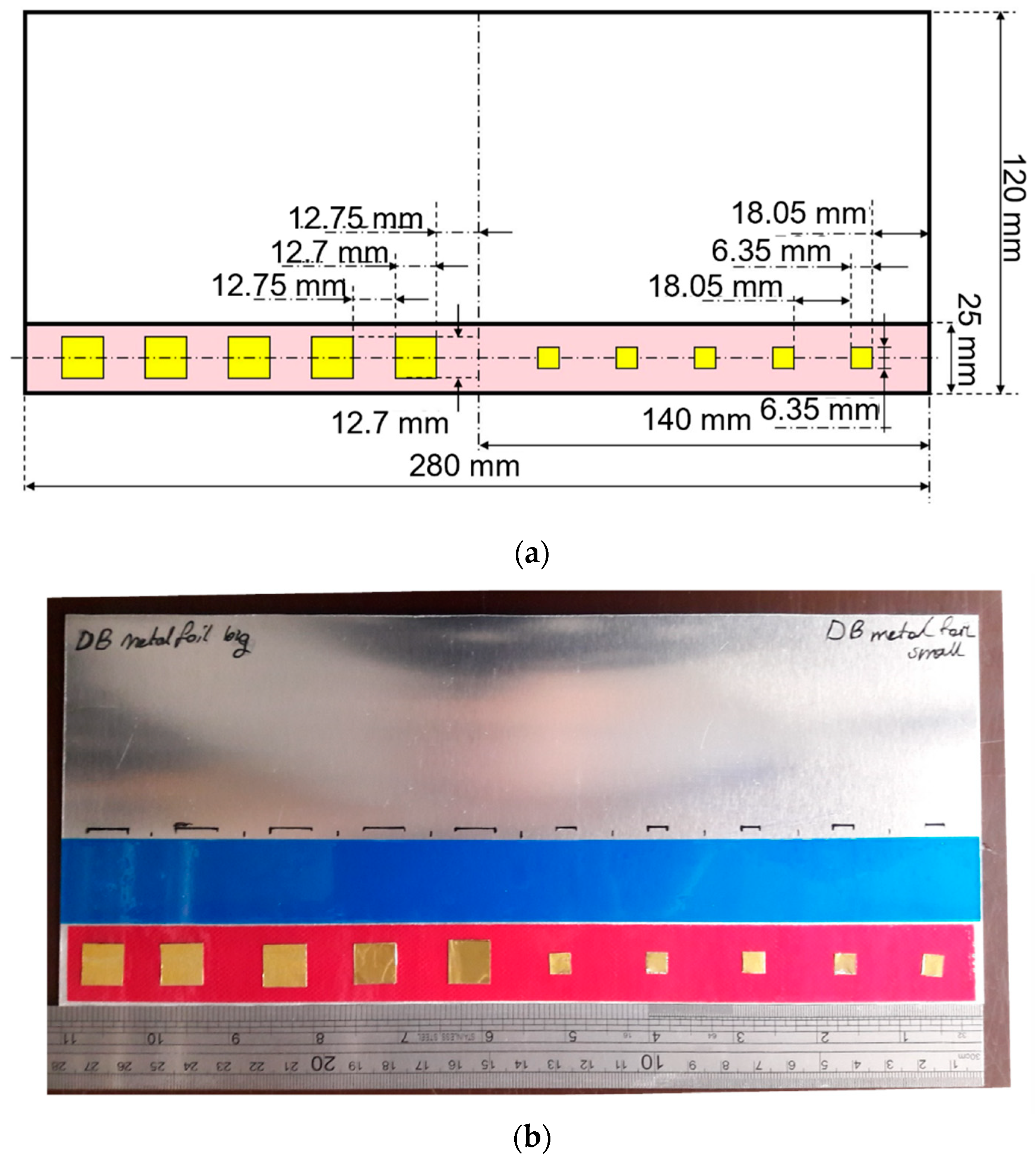
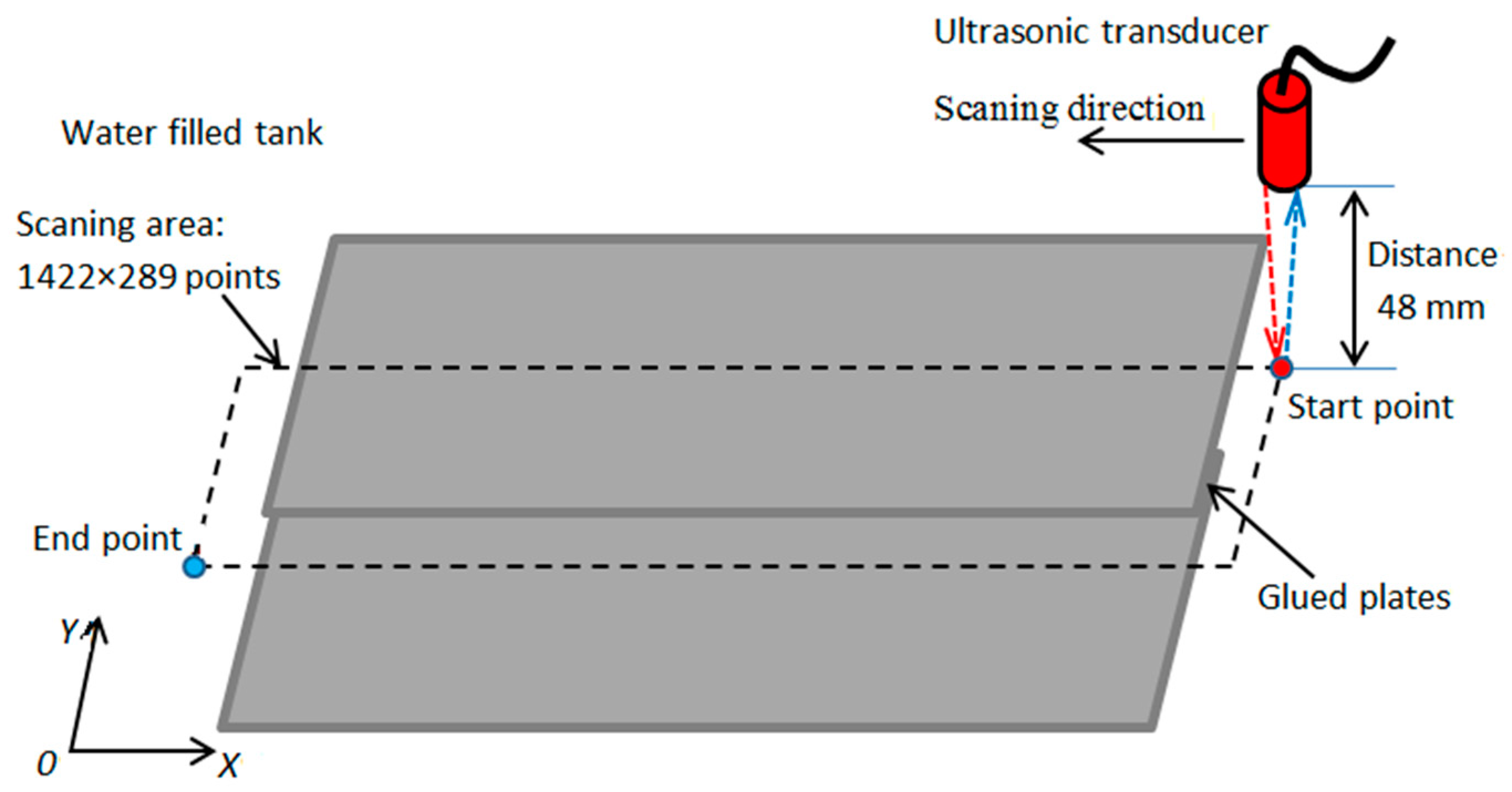
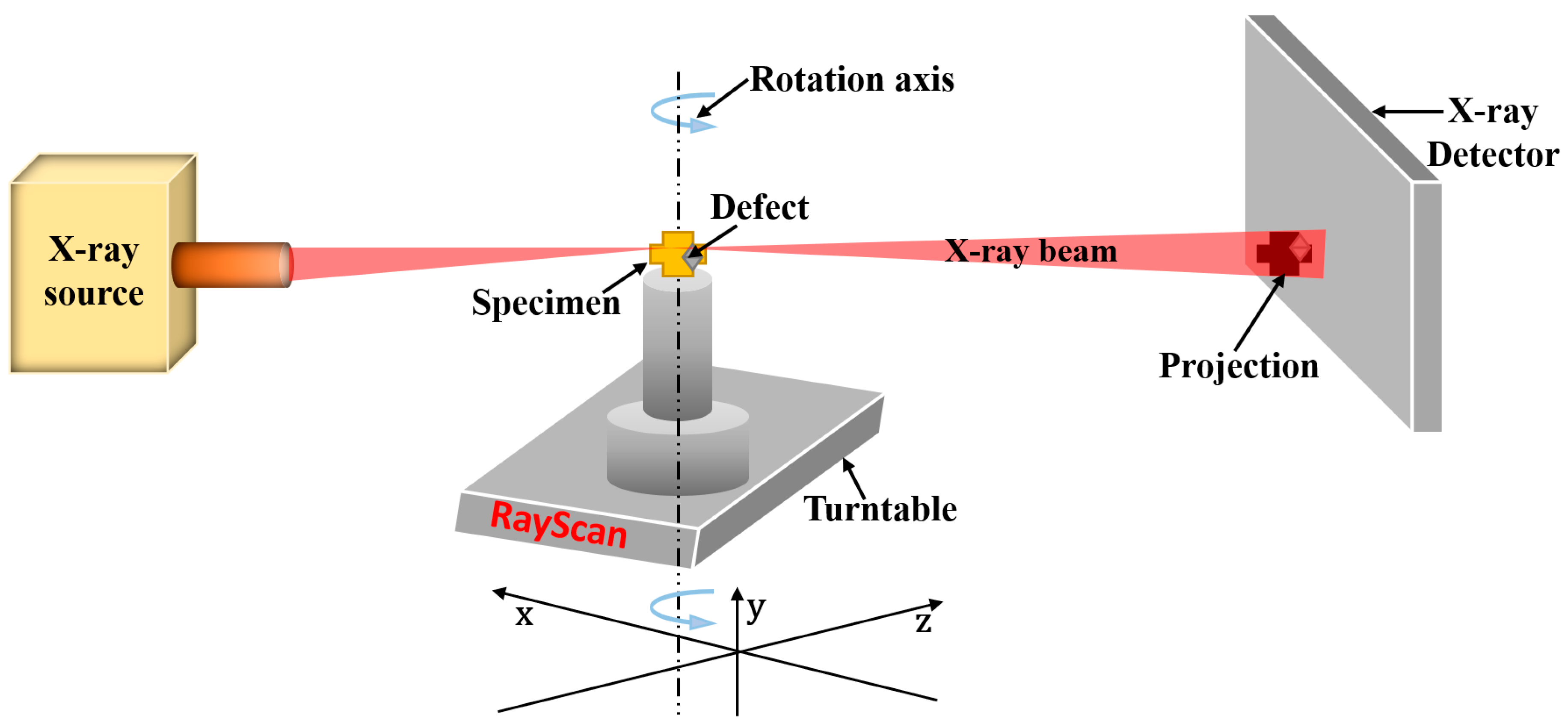
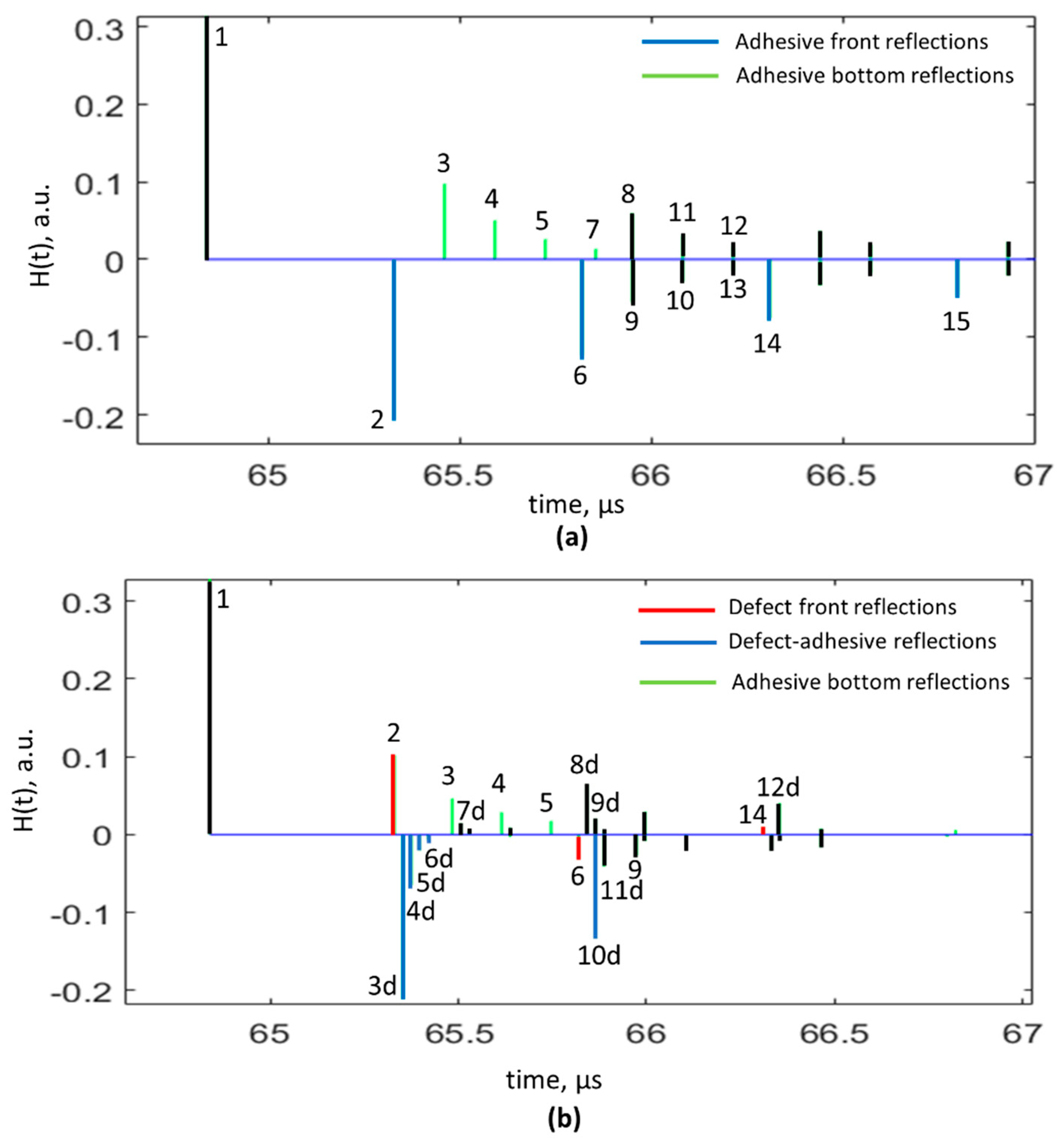
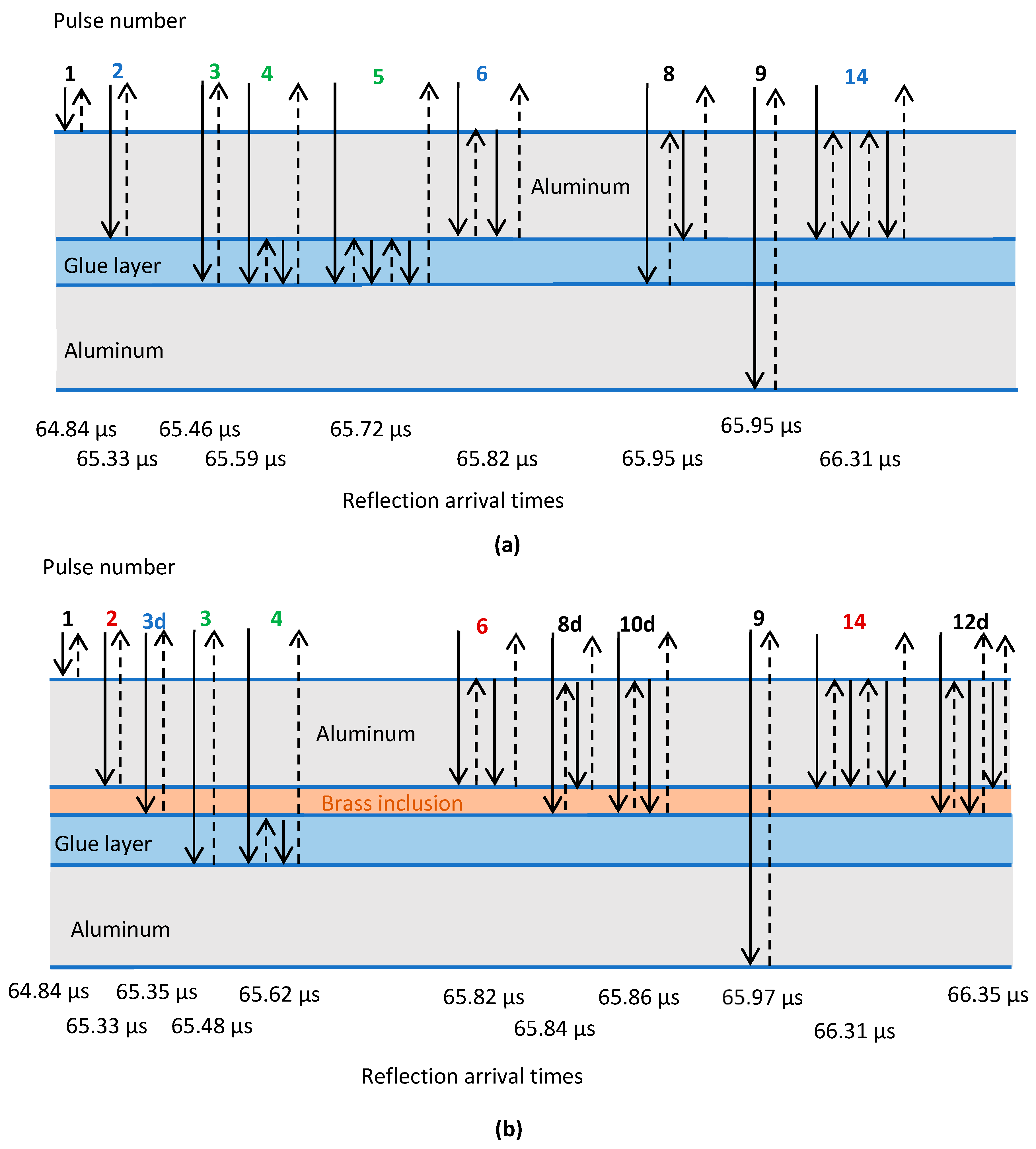

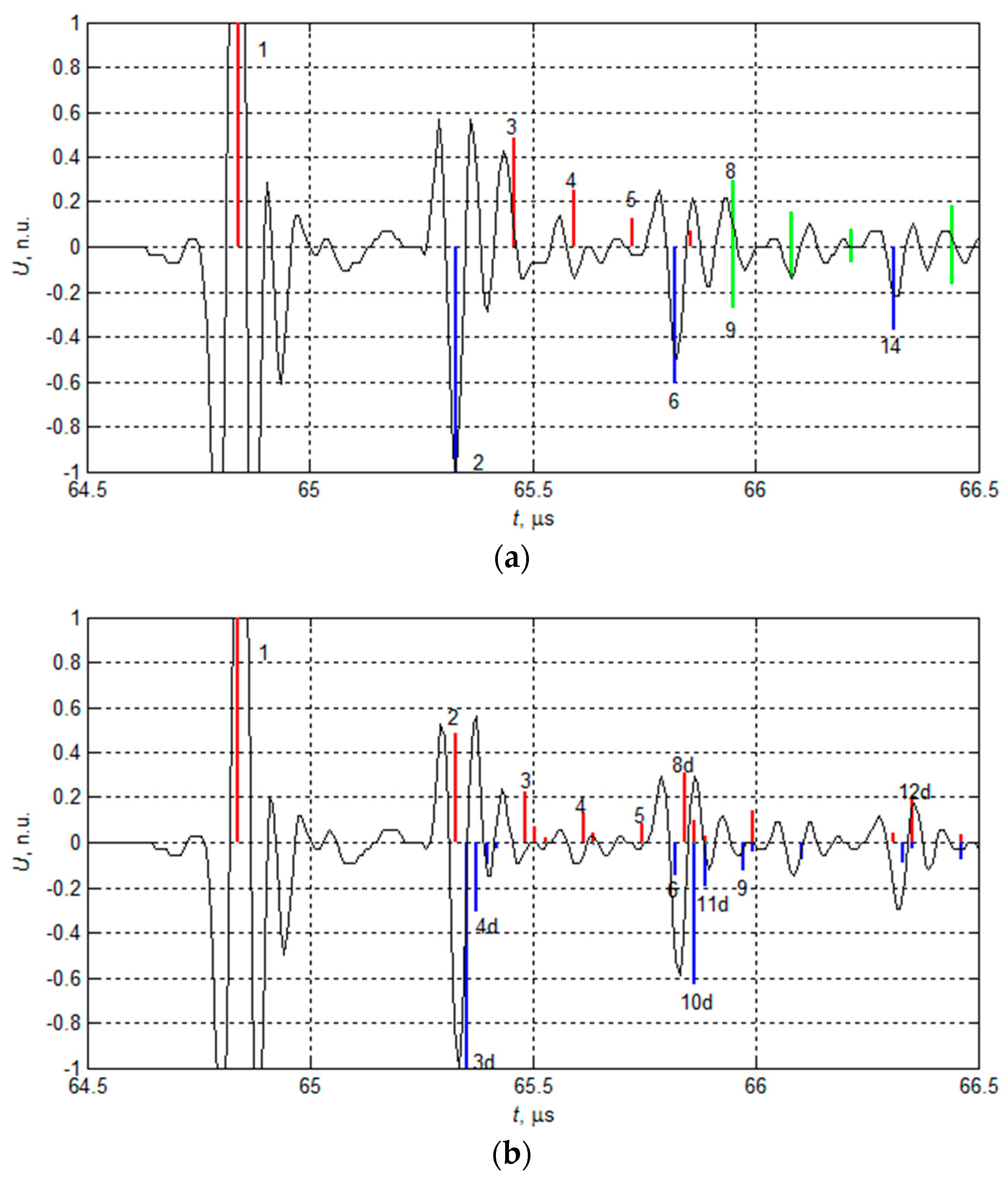
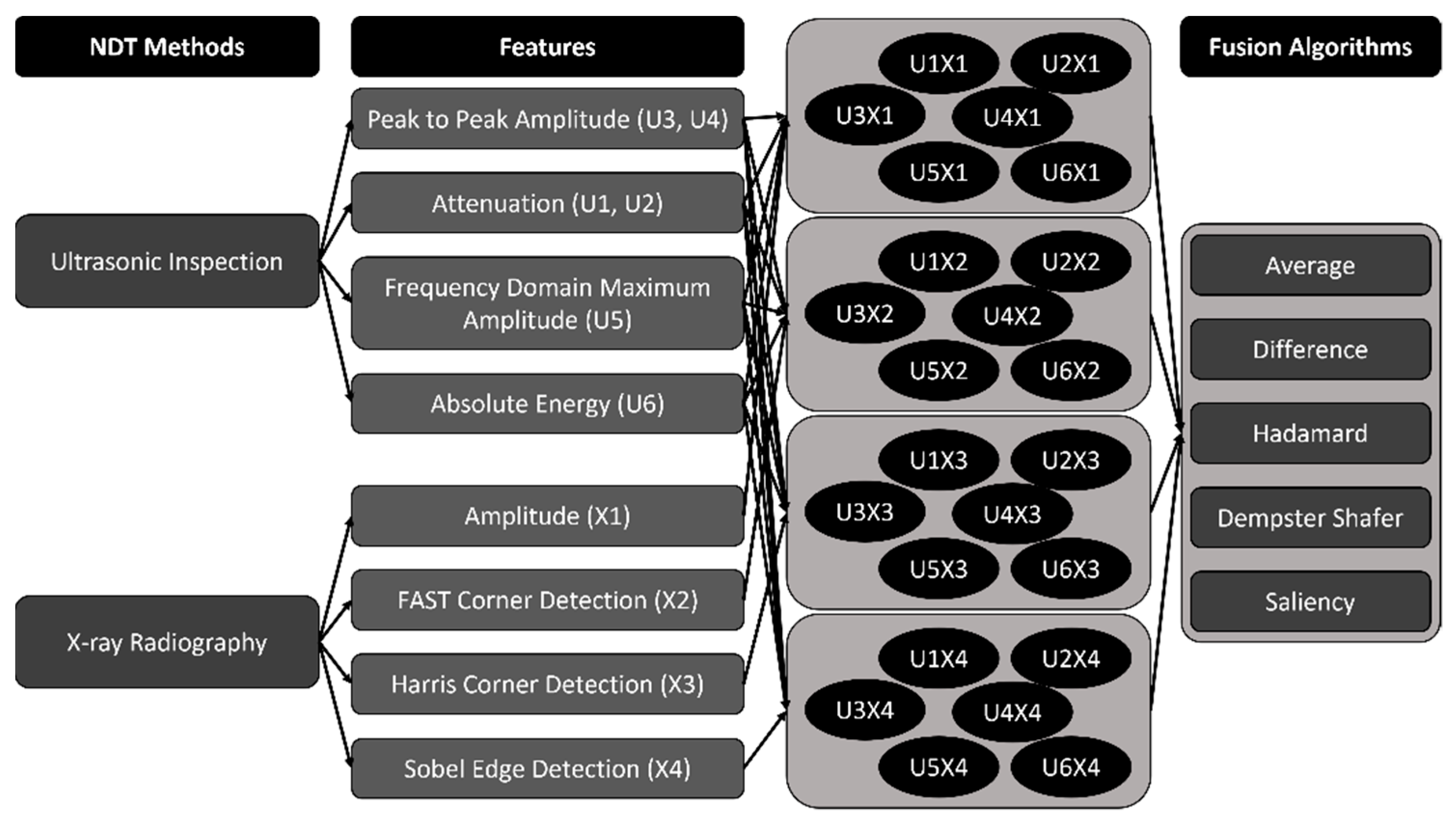
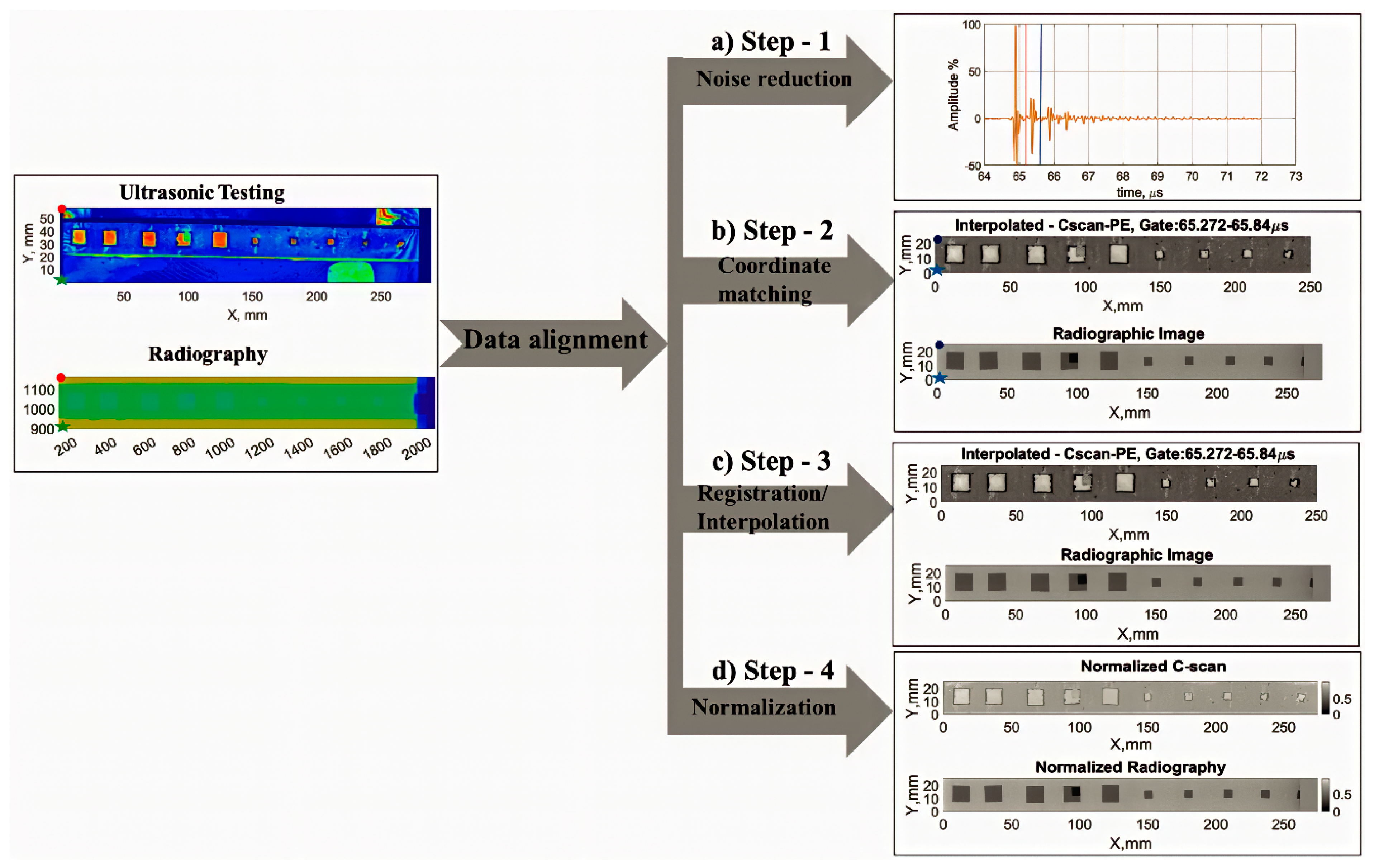
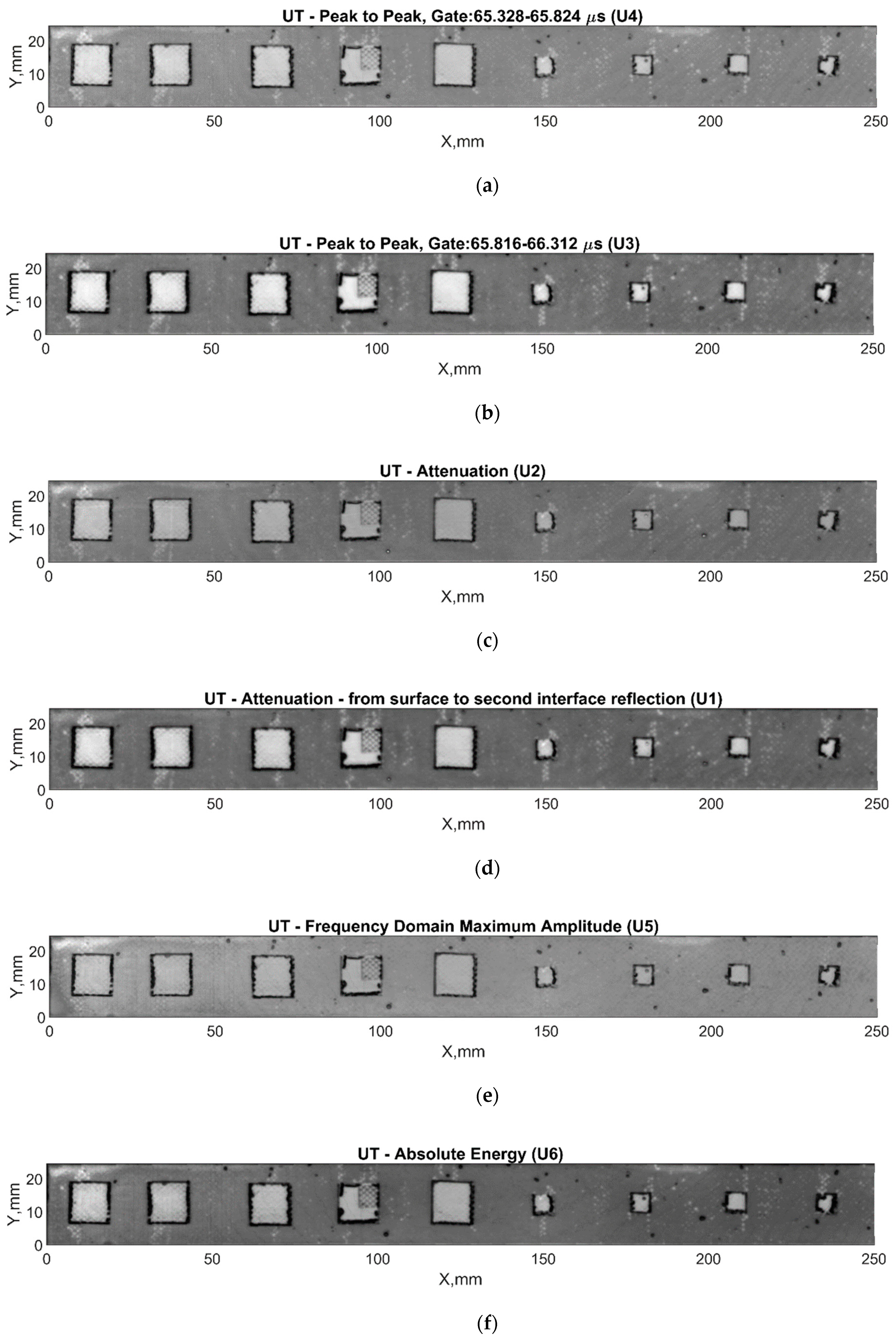
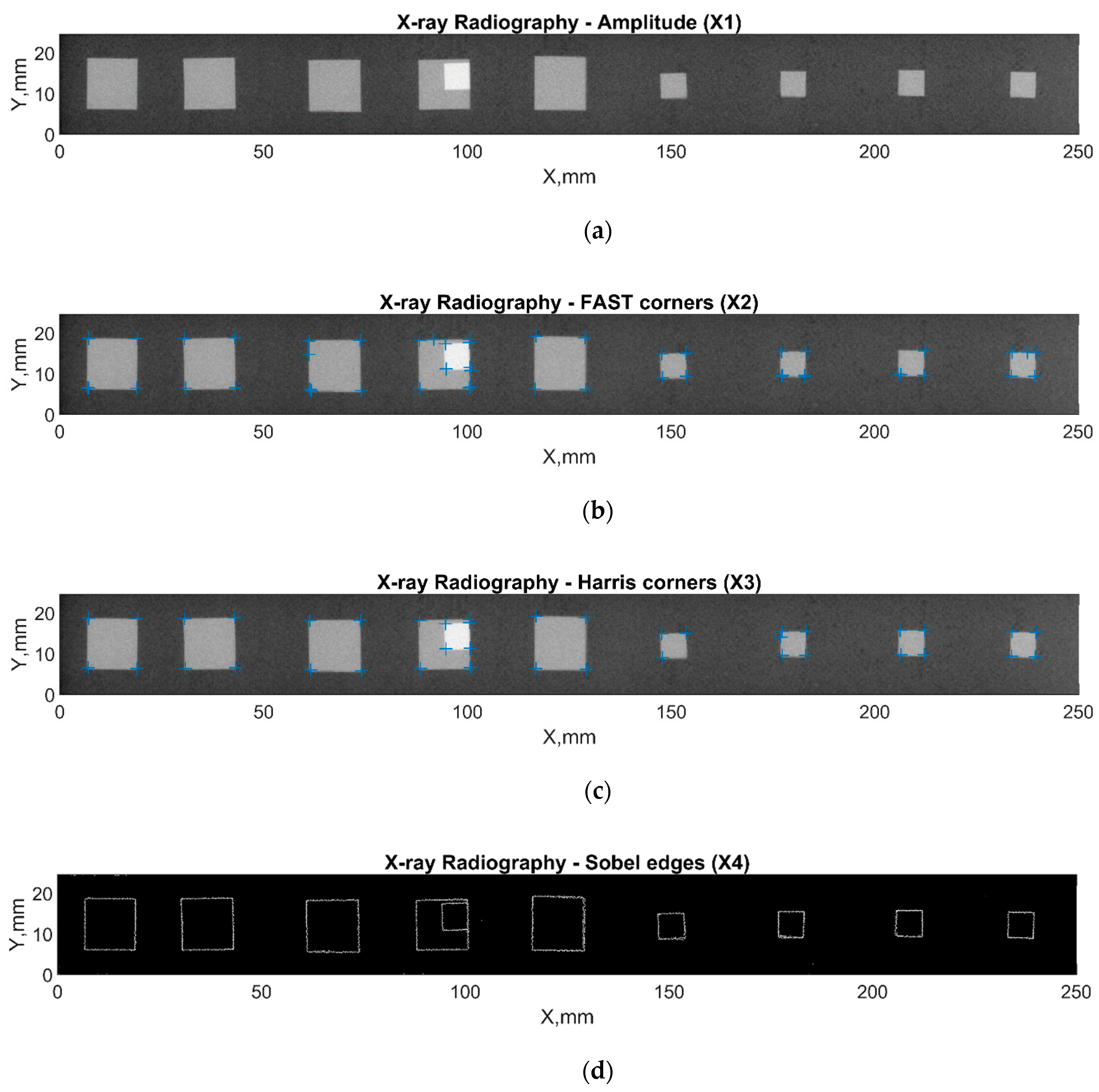
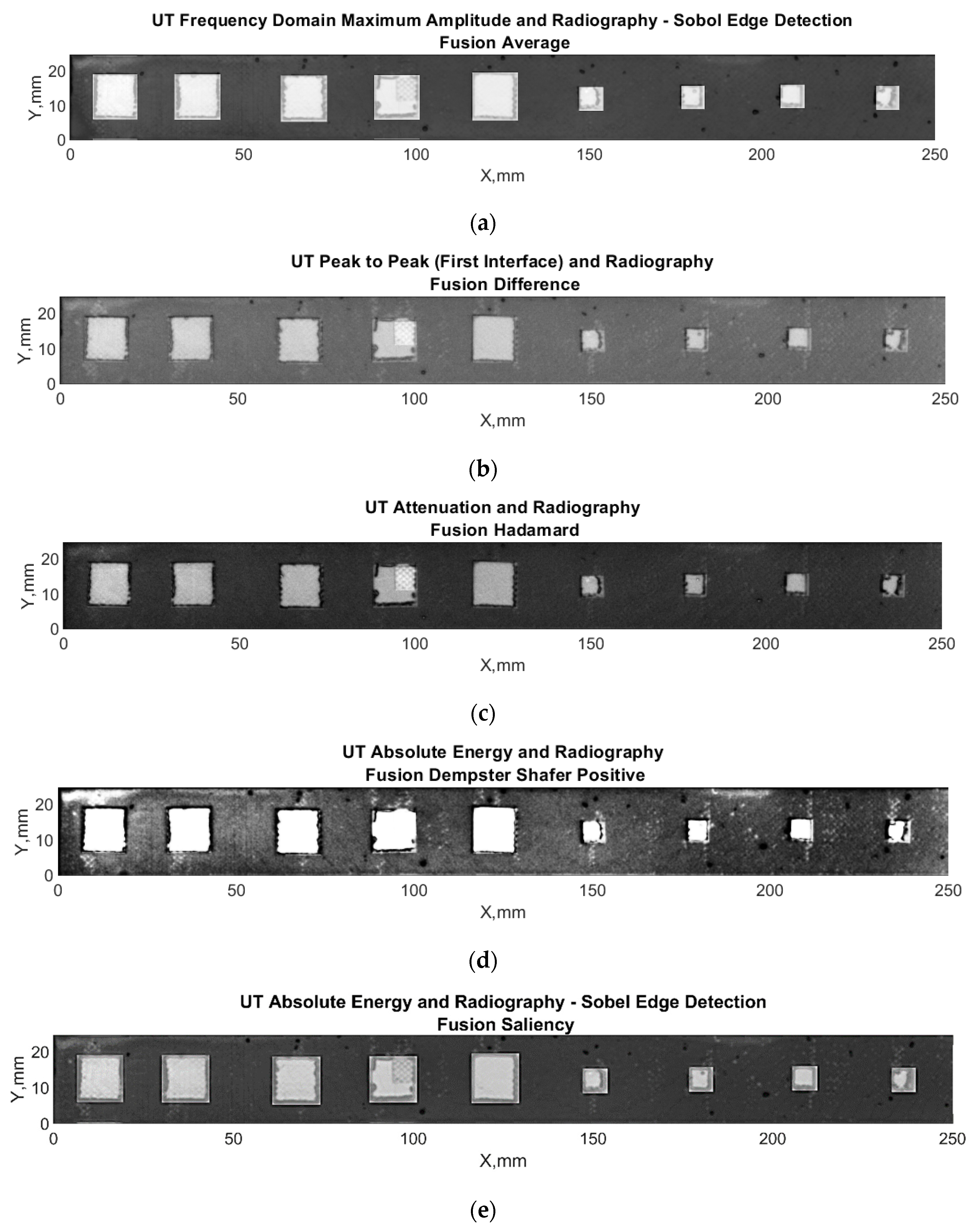
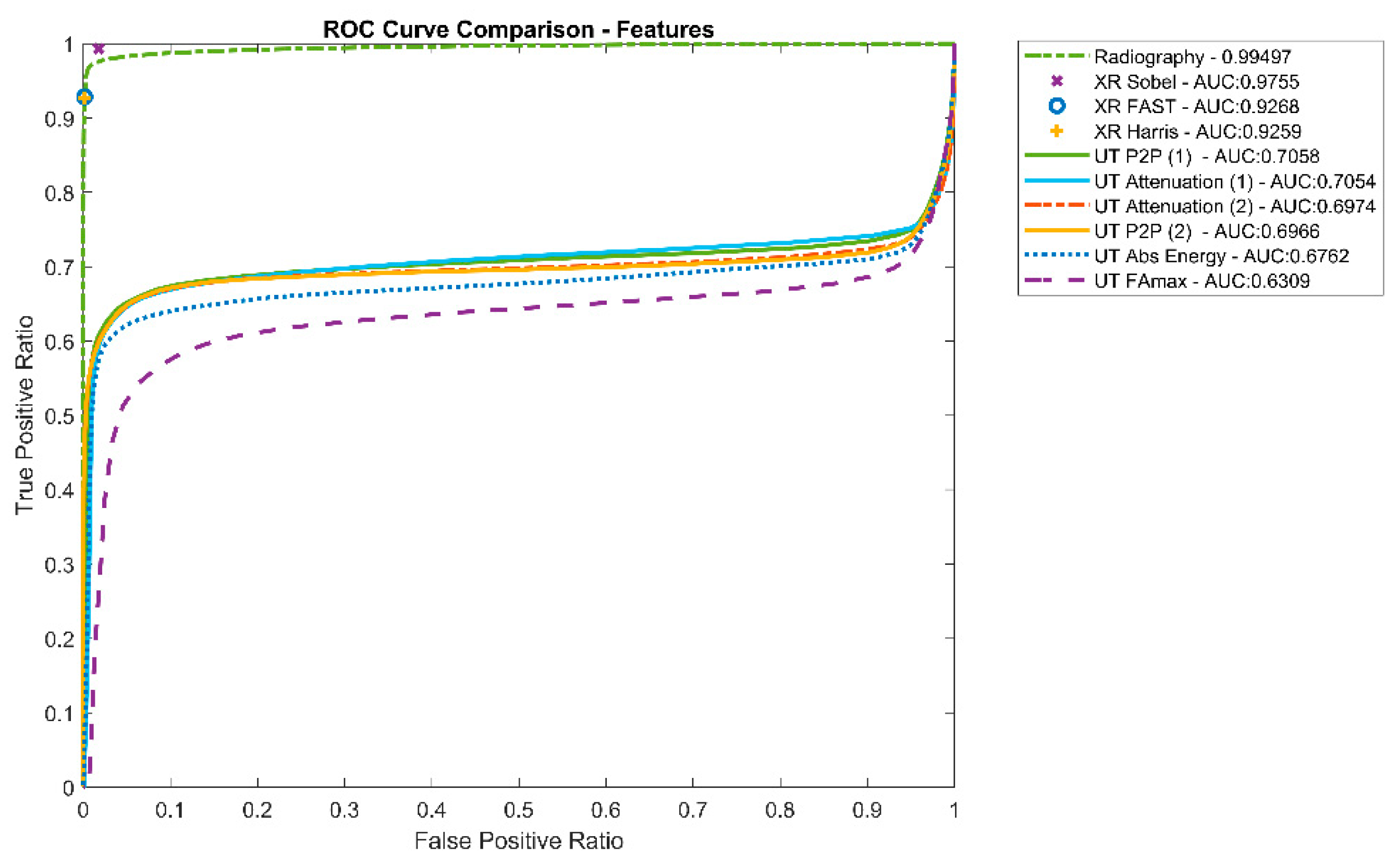
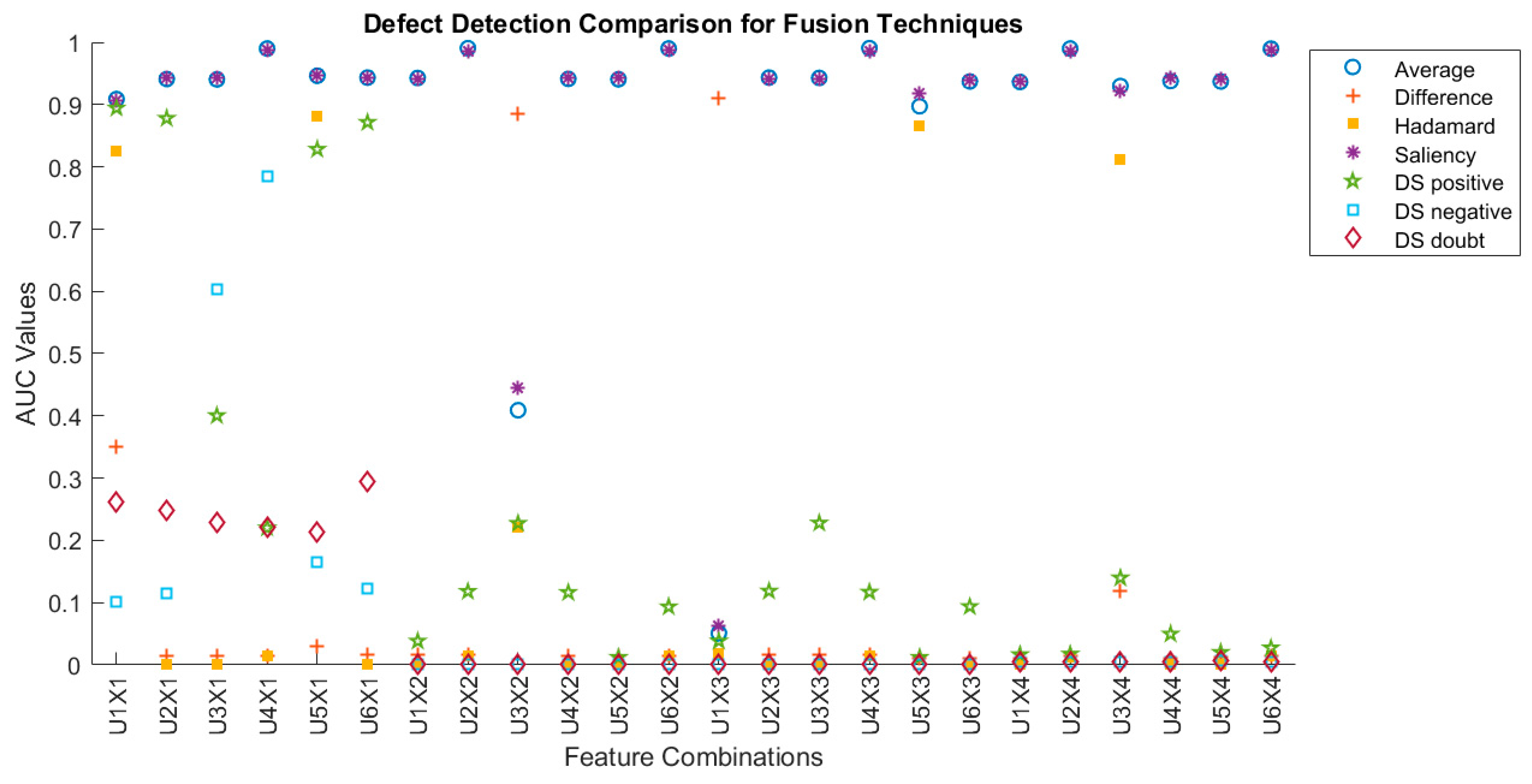
| Material | Thickness, mm | Density, kg/m3 | Ultrasound Velocity, m/s |
|---|---|---|---|
| Water | 48.5 | 998 | 1496 |
| Aluminum | 1.6 | 2780 | 6532 |
| Adhesive | 0.16 | 1214 | 2433 |
| Brass inclusion | 0.05 | 8730 | 4430 |
| NDT Technique | Feature | Formula |
|---|---|---|
| Ultrasonic | Peak-to-peak amplitude | |
| Ultrasonic | Attenuation | |
| Ultrasonic | Frequency domain maximum amplitude | |
| Ultrasonic | Absolute energy | |
| X-ray | Amplitude | none |
| X-ray | FAST | |
| X-ray | Harris Corner Detection | |
| X-ray | Sobel Edge Detection | , , |
| Fusion Algorithm | Description | Mathematical Formula |
|---|---|---|
| Average | at the pixel level, the average of feature matrices from two sources: UT 1 and RT 2 | |
| Difference | at the pixel level, the difference of feature matrices from two sources: UT 1 and RT 2 | |
| Hadamard t | pixel-wise multiplication of same-size feature matrices of two sources UT 1 and RT 2 | |
| Dempster –Shafer | evidence theory based on mass, belief, and plausibility functions 3 | |
| Saliency | the salient features of the X-ray and ultrasonic features are extracted using a basic saliency map detection algorithm |
Publisher’s Note: MDPI stays neutral with regard to jurisdictional claims in published maps and institutional affiliations. |
© 2022 by the authors. Licensee MDPI, Basel, Switzerland. This article is an open access article distributed under the terms and conditions of the Creative Commons Attribution (CC BY) license (https://creativecommons.org/licenses/by/4.0/).
Share and Cite
Jasiūnienė, E.; Yilmaz, B.; Smagulova, D.; Bhat, G.A.; Cicėnas, V.; Žukauskas, E.; Mažeika, L. Non-Destructive Evaluation of the Quality of Adhesive Joints Using Ultrasound, X-ray, and Feature-Based Data Fusion. Appl. Sci. 2022, 12, 12930. https://doi.org/10.3390/app122412930
Jasiūnienė E, Yilmaz B, Smagulova D, Bhat GA, Cicėnas V, Žukauskas E, Mažeika L. Non-Destructive Evaluation of the Quality of Adhesive Joints Using Ultrasound, X-ray, and Feature-Based Data Fusion. Applied Sciences. 2022; 12(24):12930. https://doi.org/10.3390/app122412930
Chicago/Turabian StyleJasiūnienė, Elena, Bengisu Yilmaz, Damira Smagulova, Gawher Ahmad Bhat, Vaidotas Cicėnas, Egidijus Žukauskas, and Liudas Mažeika. 2022. "Non-Destructive Evaluation of the Quality of Adhesive Joints Using Ultrasound, X-ray, and Feature-Based Data Fusion" Applied Sciences 12, no. 24: 12930. https://doi.org/10.3390/app122412930
APA StyleJasiūnienė, E., Yilmaz, B., Smagulova, D., Bhat, G. A., Cicėnas, V., Žukauskas, E., & Mažeika, L. (2022). Non-Destructive Evaluation of the Quality of Adhesive Joints Using Ultrasound, X-ray, and Feature-Based Data Fusion. Applied Sciences, 12(24), 12930. https://doi.org/10.3390/app122412930







